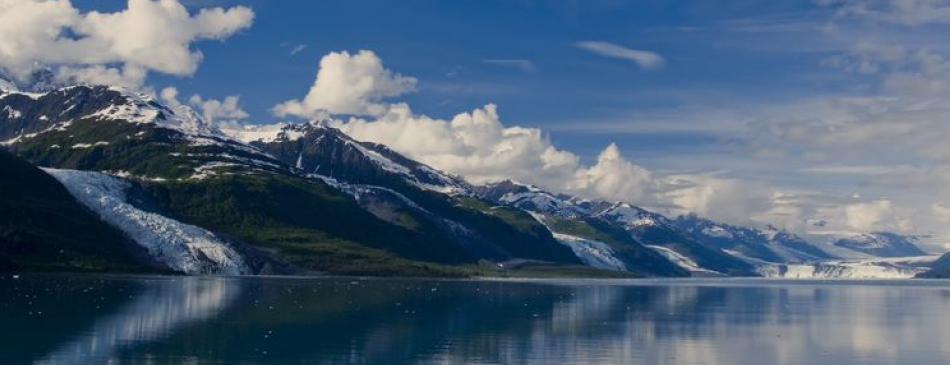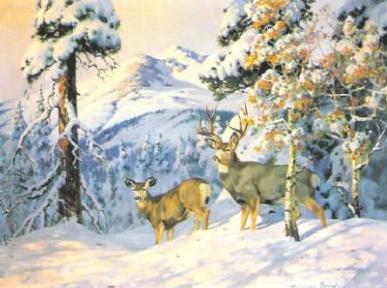|
Belmore Browne's paintings of animals and landscapes combine the attention to naturalistic detail of a naturalist and mountaineer with a bold, expressive painterly touch. Artist, writer, explorer, hunter, and mountain climber, Browne excelled in and made substantial contributions to each of these seemingly unrelated fields of endeavor, embracing them all in a remarkable life of personal discovery, expression, and achievement. His art drew sustenance from all those fields, so it is no wonder that he is now recognized as one of America’s pre-eminent mountain and wildlife painters.
Born in Tompkinsville, New York, Belmore Browne studied at the New York School of Art and the Academie Julian in Paris. As famous in the annals of mountaineering as he is as an artist, his best-known and most widely collected paintings are of Alaska, Washington, California, and the Canadian Rockies. His paintings of animals and landscapes combine the attention to naturalistic detail of a naturalist and mountaineer with a bold, expressive painterly touch.
Browne first traveled to Alaska in 1888 as an eight-year-old child on a sightseeing trip with his family. Less than two decades later, still a very young man, he undertook a remarkable series of adventures, distinguishing himself as a hunter, mountain climber, writer, and illustrator. In 1902 and 1903, still in his early twenties, he served as hunter, illustrator, and specimen preparator for the well-known naturalist Andrew Jackson Stone’s Alaska and British Columbia mammal-collecting expeditions for the American Museum of Natural History. With Stone, he explored the landscape and animals of the Stikine River region and parts of the Alaska and Kenai peninsulas. He returned to the Stikine River region of Southeast Alaska and British Columbia in 1904 and 1905 to hunt, draw, and collect specimens on his own.
After 1905, Browne turned his energy and attentions for a time to mountaineering. He was part of a group that in 1907 made the first ascent of Mount Olympus in Washington State, but his real prominence as a climber grew out of his three pioneering attempts to climb Mount McKinley in Alaska. In 1906 he joined Frederick Cook and Herschel Parker’s expedition to attempt the peak. It was on this trip that Frederick Cook, after apparently being defeated by the mountain and sending most of his crew away, claimed to have reached the summit in a very short time with a lone companion—to the acclaim of the world and the skepticism of his own expedition members. Four years later, in 1910, Browne and Herschel Parker mounted their own expedition to the mountain, hoping to climb the peak but also seeking to disprove Cook’s claim. They were unable to find a route to the summit, but did locate the peak on which Cook had posed for a “summit” photograph, a minor promontory at an elevation of 5300 feet, almost twenty miles southeast of the top of Mount McKinley. Browne’s final attempt to scale McKinley came in 1912. He and Herschel Parker were turned back by a storm just 125 feet short of the summit. Browne later wrote many articles about his experiences on the mountain and in 1913 published "The Conquest of Mount McKinley," an extensive account of all three climbs. Browne is perhaps best known for his many paintings of the Canadian Rockies, the largest collection of which is at the Glenbow-Alberta Institute in Calgary, Alberta, Canada. His works are also widely represented in American museums, among them the Smithsonian American Art Museum, Shelburne (Vermont) Museum, National Museum of Wildlife Art, Amherst College Museum, and Anchorage Museum of History and Art.
Johnny Aculiak| Edwin Tappan Adney|
George Twok Aden Ahgupuk| Alvin Eli Amason| Saradell Ard| Belmore Browne| Vincent Colyer| Jules Bernard Dahlager| Lockwood De Forest| Frederick Samuel Dellenbaugh| William Franklin Draper| | Henry Wood Elliott| John Fehringer| Claire Fejes| Louis Agassiz Fuertes| Magnus Colcord Heurlin| Norman Jackson| Rockwell Kent| Sydney Mortimer Laurence| Fred Machetanz| Marvin Mangus| Milo Minock| James Kivetoruk Moses| Rie Munoz| Joseph Henry Sharp| James Everett Stuart| John Webber| Kesler Woodward|
|




